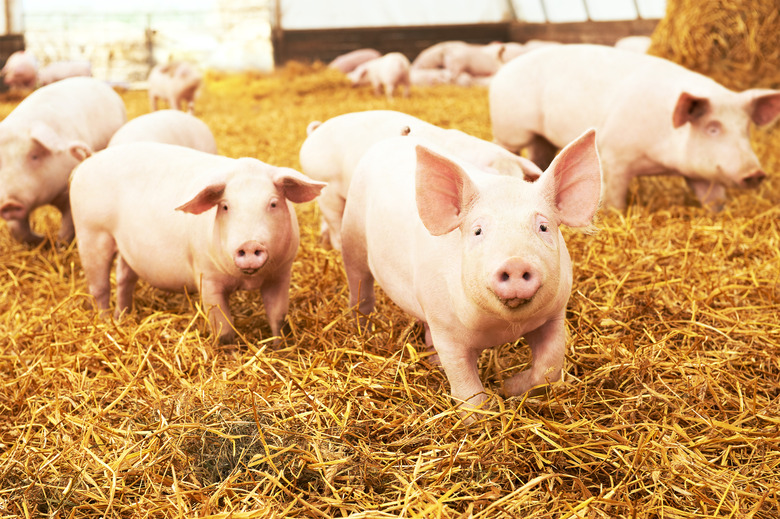Gestation Period Of A Hog
Hogs are feral or farm-raised pigs. A female hog–a "gilt" if she has never given birth or "farrowed" before, and a "sow" if she has–is ready for breeding when she's about 32 weeks old.
The average gestation period for hogs will be enable a female to produce two litters a year and will give birth to about nine piglets in each litter.
The pig gestation period for a wild hog may take longer to reach reproductive age, may produce smaller litters and may take longer to wean her piglets because of environmental factors.
Embryo Migration
Embryo Migration
About nine to 12 days after mating and conception, embryos will migrate throughout the female hog, the sow's, uterus. They'll disperse so they'll be divided in roughly equal numbers in the different horns of her uterus.
If all the fertilized embryos stay in one horn, the sow will spontaneously abort which would end the gestation period for hogs.
Estrogen Spike
Estrogen Spike
In a gestation period for hogs, day 12 after conception is time for the "estrogen spike". The sow will have experienced an increase of her estrogen, which will trigger the production of the blastocyst. About 12 to 16 days after conception, the sow's blastocyst elongates. It starts out at about 4 millimeters long and will increase until it's about 1 meter long.
This higher level of estrogen, which is triggered by the presence of at least four embryos, is necessary to continue swine gestation. If the estrogen dips, such as by the loss of embryos until there are less than four total in the uterus, the sow will spontaneously abort.
Detecting Swine Gestation and Pregnancy
Detecting Swine Gestation and Pregnancy
If the female hog, a sow, doesn't return to estrus 17 to 21 days after conception, it is the first external sign she may be in a pig gestation period. After 25 days, a vet or farmhand can use ultrasonography to determine if the sow is gestating.
If the vet or farmhand takes an ultrasound, they must be careful that they don't get a false positive from the hog's full bladder.
Fetal Skeleton
Fetal Skeleton
By about day 30 of gestation, the fetal pig has formed a skeleton. If the fetal pig is aborted up to that point, or before roughly day 35, it'll be completely reabsorbed into the sow.
If the fetal pig is spontaneously aborted after, the sow will be unable to absorb the skeleton because of the calcium in the bones; the fetal pig will mummify. If multiple swine are having spontaneous abortions so late in the pregnancy, it's possible a disease exists in the herd.
Readying for Lactation
Readying for Lactation
During swine gestation, wild hogs will eat more than usual to bulk up for the lactation period, when they will not eat much at all. In farmed hogs, however, the sow is likely to eat as much as usual during the lactation period.
If she gains too much weight during gestation, it could ultimately result in her not producing enough milk; she should not be given more food than usual during gestation.
Fetal Immune System
Fetal Immune System
By 60 days, the fetal pig's immune system will be developed.
Birth
Birth
After about three months, the sow's belly and udder will look enlarged. The fetal pigs will be ready to be birthed. The sow will go into labor after about 114 days of gestation, give or take two days. She will likely go into labor at night because sows are likely to seek a dark, quiet place to give birth.
Sow Recovery, Lactation, and Weaning
Sow Recovery, Lactation, and Weaning
The domesticated sow will nurse her piglets for two to three weeks after birth, until the piglets reach 10 to 20 pounds each. At that point, she will be ready to be inseminated by the boar–a male hog–again and begin another pig gestation period.
Cite This Article
MLA
Rousseau, Sasha. "Gestation Period Of A Hog" sciencing.com, https://www.sciencing.com/gestation-period-hog-8576655/. 22 November 2019.
APA
Rousseau, Sasha. (2019, November 22). Gestation Period Of A Hog. sciencing.com. Retrieved from https://www.sciencing.com/gestation-period-hog-8576655/
Chicago
Rousseau, Sasha. Gestation Period Of A Hog last modified March 24, 2022. https://www.sciencing.com/gestation-period-hog-8576655/
